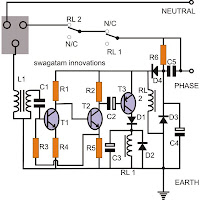An Earth leakage circuit breaker unit will silently monitor the electrical condition of your appliances and the Earth connection of your house. If anything goes wrong with them it will instantly switch off the mains and stop any further associated loss. A simple ELCB circuit is discussed here.
A simple circuit of an Earth leakage circuit breaker also called ground fault circuit interrupter is discussed in this article. The circuit once built and installed will silently monitor the “health” of the earth connection of your house and the connected appliance. The circuit will immediately switch off the mains on detecting a missing earth connection or a current leakage through the appliance body.
A leaking current through earth terminal is probably more dangerous than a short circuit in a domestic wiring. A short circuit hazard is visible and mostly tackled through a fuse or a circuit breaker unit. But earth current leakages may remain hidden for years, eating up your precious electricity and also weakening or deteriorating the wiring conditions and also the appliances. Moreover if the earth connection is not properly grounded due to improper conduction or breakage, the leakage may turn into a lethal shock over the body of the appliance.
Commercially available earth leakage circuit breaker units are very costly and bulky, involving complicated installation procedure. I have designed a simple circuit which is low in cost and yet handles the situation handsomely. The device will detect any current exceeding above 5mA through the earth passage and switch off the mains. The connected appliance will then need a diagnose or a total elimination. A leaking appliance not only wastes your electricity but also can be dangerous fatally.
Circuit Description
The proposed ground fault circuit interrupter or ELCB utilizes a simple principle of detecting the AC signal rather the applied or the leaking voltage. Here, the leaking AC may be too small to be detected as a potential difference using simple voltage detection configuration, therefore the leakage is effectively sensed as a frequency, using a simple audio amplifier stage.
As shown in the diagram, a simple bootstrapped amplifier network forms the main sensing stage of the unit.
Transistors T1 and T2 along with the associated passive components are wired up into a small two stage amplifier. The introduction of R3 becomes very crucial as it provides a positive feed back to the input making the circuit more stable and respond to minutest input signals.
The inductor L1 basically has two windings, the primary which is connected to the earth point of the socket has less number of turns, the secondary winding has six times more number of turns and is integrated to the input of the circuit via C1.
The role of L1 is to amplify any AC induced into its primary winding which can only happen in case of a leakage through the body of an appliance connected to the socket.
The above amplified leakage voltage is further amplified to a level enough to activate RL1, instantly disabling the input to the appliance and indicating the earth leakage fault.
Capacitor C5 along with D3 and C4 forms a standard transformerless power supply to power the circuit. D3 performs a dual function of rectification and surge suppression.
Interestingly the main earth connection itself becomes the negative of the circuit instead of the neutral line. Also since RL2 is directly connected to the supply across the positive of the circuit and the earthing, simply means that if the earthing becomes weak or disconnected, the relay will deactivate, cutting off the AC mains to the appliance, so it effectively indicates the health of the earthing and safeguards the house from faulty or missing earth connections.
ELCB Circuit Parts List.
R1 = 22K,
R2 = 4K7,
R3 = 100K,
R4 = 220E,
R5 = 1K,
R6 = 1M,
C1 = 0.22/50V,
C2 = 47UF/25V,
C4 = 1000UF/25V,
C6 = 2UF/400V PPC,
T1, T2 = BC 547B,
T3 = BC 557B,
Relays = 12V, 400 Ohm, SPDT,
All Diodes are = 1N4007,
L1 = Coil wound over a bobbin used normally with E-cores (smallest size,) begin winding 50 turns of 25 SWG wire first, tie it up and solder it to produce the primary terminals at one side of the bobbin. Now using 32 SWG copper wire, wind 300 turns over the primary winding, as before tie the ends to the other side of the bobbin by soldering. Insert and fix the coil within the E-cores. Secure it tightly using PVC tape

0 Response to "Make a Simple Earth Leakage Circuit Breaker (ELCB) Circuit"
Posting Komentar